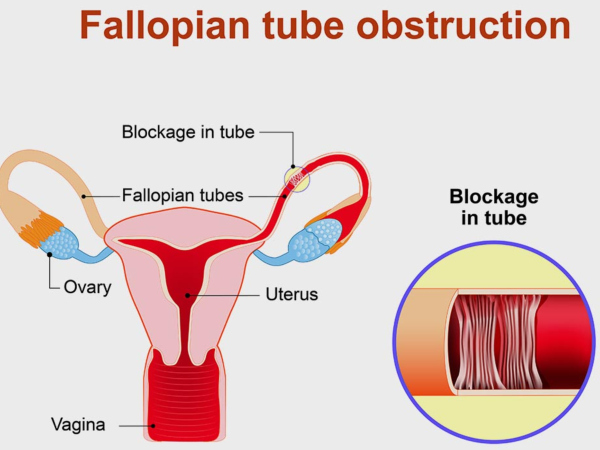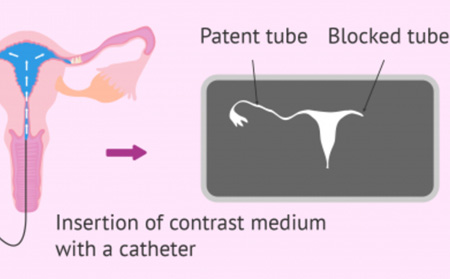Tubal Patency Test / HSG
Tubal patency refers to the openness and lack of blockage in the fallopian tubes. If the fallopian tubes are patent (open), an ovulated egg can be fertilized within one of the tubes and then travel to the uterus for implantation.
If the tubes are blocked, the sperm and egg cannot meet, and conception will not be possible. Blocks or occlusions in the fallopian tubes are a significant cause of female factor infertility.
Blocked tubes can happen for several different reasons, but no matter the cause, your doctor will diagnose it with a test called a hysterosalpingogram.
Tubal patency is determined by an x-ray test called a hystero-(uterus)salpingo-(fallopian tube) graphy (HSG). HSG is a standard radiological imaging study that is used to determine if the fallopian tubes are open and free of disease.
It is usually done in the first 10 days of the menstrual cycle. Sometimes the tubes will appear to be blocked on the HSG when they are actually open.
The timing of the HSG study during the menstrual cycle, or the use of hormonal contraception may make a difference in whether the tubes appear blocked on the HSG when they are actually patent.

Laparoscopy Surgery. Image source: Symptoms, Causes and Treatment for Fertility. Accessed via https://laparoscopysurgeries.com/blocked-fallopian-tubes-symptoms-causes-and-treatment-for-fertility/


Royal Australian College of General Practitioners. Image source: Infertility and the GP.
What is involved in a HSG test?
A hysterosalpingogram is a special kind of x-ray that involves administering an iodine dye via the cervix, into the uterus and fallopian tubes, while a transvaginal ultrasound (TVUS) is performed.
This allows the technician to see the fluid being injected and assess whether or not it is freely passing through the fallopian tubes. If there is a blockage in any part of one of the fallopian tubes, the dye will struggle to flow around it.
This will be seen on the ultrasound and allows the technician to identify the location of the obstruction. The test is intended to check the general uterine shape and to see if the fallopian tubes are clear.
Why is the HSG Test Performed?
Tubal patency test is commonly done in women with an infertility diagnosis or those who have had pregnancy problems, such as multiple miscarriages. Hysterosalpingography can help diagnose the cause of infertility.
If you’ve had tubal surgery, your doctor may order a hysterosalpingography to check that this surgery was successful. If you had a tubal ligation, your doctor may order this test to ensure that your tubes are closed properly. The test can also check that a reversal of tubal ligation was successful in reopening the fallopian tubes.
Complications from a hysterosalpingography are rare. Possible risks include:
- allergic reaction to contrast dye
- endometrial (uterine lining) or fallopian tube infection
- injury to the uterus, such as perforation
What do the tubal patency results mean?

inviTRA. Image source: Blocked Fallopian Tubes – Causes, Diagnosis & Treatment. Accessed via https://www.invitra.com/en/fallopian-tube-obstruction/
The HSG helps the doctor check out two important factors:
- Whether or not the fallopian tubes are blocked or open. If the fallopian tubes are blocked, a woman will not be able to get pregnant, because the egg can’t meet the sperm.
- Whether or not the shape of the uterus is normal. In 10 to 15 percent of women with recurrent pregnancy loss, an abnormally shaped uterus is to blame. Some uterine abnormalities can be treated with surgery.
If the x-ray shows a normal uterine shape, and the injected dye spills freely out from the ends of the fallopian tube, then the test results are considered normal.
This doesn’t, however, mean your fertility is normal. It just means whatever may be wrong wasn’t seen on the HSG. Hormonal-based causes of infertility will not be seen on an HSG.
If the dye shows an abnormally shaped uterus, or if the dye does not flow freely from the fallopian tubes, there may be a problem.
Is Pregnancy after Tubal Patency Tests More Likely?
The dye flushes out the fallopian tubes, clearing partial, minor blocks in some women. In this is the case, the HSG test result will show unblocked fallopian tubes. However, some contrast may seem to stop and then continue on the x-ray. This may be the dye breaking through very thin adhesions.
Another possibility is that the dye solution enhances the endometrium (the lining of the uterus) in some way, making it easier for an embryo to implant successfully. It may have an anti-inflammatory effect.
The dye solution somehow affects the area surrounding the ovaries, enhancing ovulation.
Treatment for a blocked tube depends on the location of the obstruction. If only one tube is blocked, fertility medications could be used to increase the chances of ovulation on the side of the patent tube.
Alternatively, laparoscopic surgery may be indicated to remove the blockages. Women with tubal obstruction who wish to become pregnant and do not want to undergo surgery may consider in vitro fertilization (IVF).
Our experienced fertility specialist can advise you on which fertility tests you should have. We can also help you with the next steps if the results reveal that you need extra help to get pregnant.
If you want to arrange a tubal patency test / HSGor other fertility checks, feel free to get in touch to talk to our fertility specialist. We’ll help you to get the tests you need.
Book Your
Appointment today!
Make an Appointment


